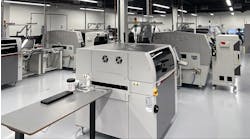Orders for manufacturing technology totaled $513.4 million in April—the second month in a row surpassing half a billion dollars, according to AMT's (The Association For Manufacturing Technology) latest U.S. Manufacturing Technology Orders Report.
The United States Manufacturing Technology Orders (USMTO) Report is based on the totals of actual data reported by companies participating in the USMTO program.
The report provides regional and national U.S. orders data of domestic and imported machine tools and related equipment. Analysis of manufacturing technology orders provides a reliable leading economic indicator as manufacturing industries invest in capital metalworking equipment to increase capacity and improve productivity.
AMT reports that April orders decreased about 7% from the previous month but were 27.5% larger year-over-year. The total amount of orders through April 2022 was $1.9 billion.
“Despite these strong results, there’s clearly been a lot of news related to declining consumer sentiment, everything from inflation to high-interest rates to the war in Ukraine,” said Douglas K. Woods, president of AMT.
“While consumer sentiment has been low since April 2021, consumer demand continues to hit record highs, leveraging consumers’ amassed savings as well as large capital investment pools looking for high-value market opportunities.
“April USMTO numbers reflect ongoing consumer spending, particularly fueled by demand for manufactured goods, such as aerospace and other capital-heavy industries,” Woods continued.
“Based on available economic projections, we had anticipated orders to gradually soften through the middle of the year. However, that pullback has not happened, and signs point to above-average orders for manufacturing technology into the beginning of the summer. When supply chain issues are minimized, the continued pace of consumer-driven demand could necessitate additional capacity, prolonging a potential slowdown in the industry.”










